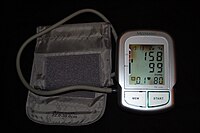
Photo from wikipedia
Chronic kidney disease (CKD) patients have greater blood pressure reactivity to acute cardiovascular stressors and a higher prevalence of hypertension; however, limited information is available regarding the potential role of… Click to show full abstract
Chronic kidney disease (CKD) patients have greater blood pressure reactivity to acute cardiovascular stressors and a higher prevalence of hypertension; however, limited information is available regarding the potential role of impaired baroreflex control in non-dialysis CKD patients. The baroreflex plays a homeostatic role in beat-to-beat blood pressure (BP) regulation and impaired cardiac baroreflex sensitivity (cBRS) has been associated with increased blood pressure reactivity and cardiovascular events. However, previous studies in CKD have shown mixed results or have been confounded with co-morbid conditions such as hypertension. Therefore, the aim of the present study was to test the hypothesis that baroreflex control of heart rate (HR) is attenuated in patients with CKD compared to hypertensive controls. Additionally, we tested whether cardiovascular risk factors such as age, arterial stiffness, and BMI are associated with cBRS in patients with CKD. In 15 stage III-IV CKD patients [7 male/8 female, age: 60±10 yr, 14 Black/1 White, systolic/diastolic BP: 145.1±20/71.9 ± 10 mmHg, 100% hypertensive, BMI: 31±5 kg/m2] and 5 matched controls [5 male/0 female, age: 56 ± 4 yr, 5 Black/0 White, systolic/diastolic BP: 130.6± 24/69.0 ±15 mmHg, 100% hypertensive, BMI: 34±4 kg/m2], continuous beat-to-beat BP (finger photoplethysmography) and HR (electrocardiography) were recorded while resting supine for 5-minutes. We utilized the sequence technique in which the slopes of the systolic BP and RR interval relationships were calculated and averaged for a measure of cBRS. Arterial stiffness was measured by carotid-to-femoral pulse wave velocity (PWV) using tonometry. Systolic beat-to-beat BP (CKD 145.1±20 vs. CT 130.6± 24 mmHg, P = 0.184) and HR (CKD 64.2 ± 7 vs. CT 67.5 ± 6 beats/min, P = 0.352) were similar between groups. Likewise, no differences in spontaneous cBRSall (CKD 10.495 ± 5 vs. CT 8.800 ± 3 ms/mmHg, P = 0.487), cBRSup (CKD 9.138 ± 5 vs. CT 9.776 ± 3 ms/mmHg, P = 0.778) and cBRSdown (CKD 11.238 ± 6 vs. CT 8.218 ± 3 ms/mmHg, P = 0.267) were observed. No significant correlations were observed between cBRS with age, BMI, PWV, or eGFR. In summary, contrary to our hypothesis, our preliminary data suggest that CKD does not worsen cBRS compared to age- and co-morbidity-matched controls, but greater sample size is needed to support our results. Funded by American Physiological Society, NIH R01HL135183, NIH R61 AT10457, and VA Merit I01CX001065. This is the full abstract presented at the American Physiology Summit 2023 meeting and is only available in HTML format. There are no additional versions or additional content available for this abstract. Physiology was not involved in the peer review process.
Journal Title: Physiology
Year Published: 2023
Link to full text (if available)
Share on Social Media: Sign Up to like & get
recommendations!